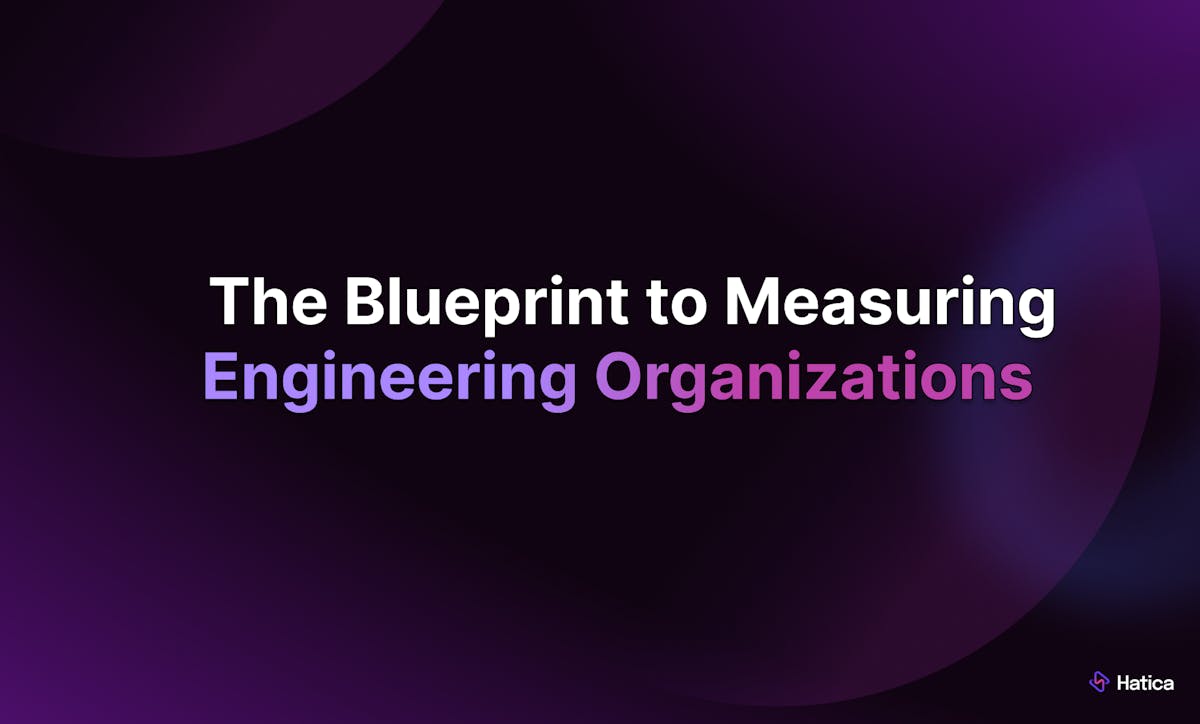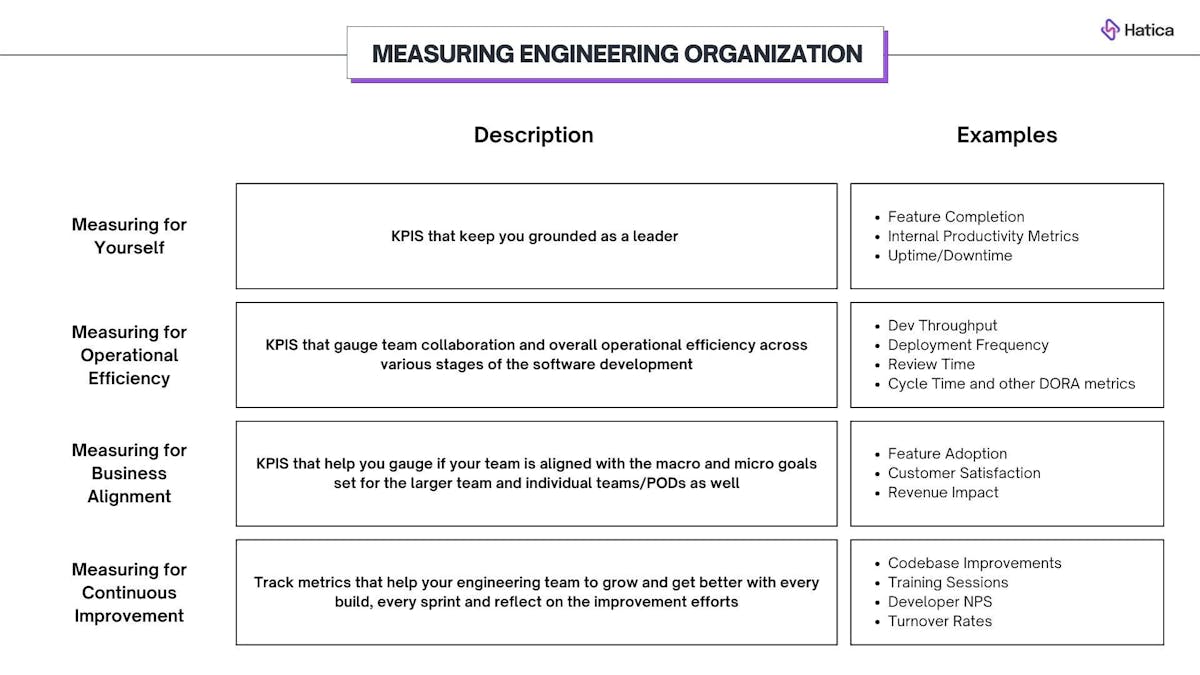Engineering’s work touches a lot of different groups across the company, each with its own priorities. From executives to cross-functional teams, everyone needs specific insights to really see how engineering supports the bigger picture. For a helpful breakdown of what each group typically cares about, check out this blog: Guide to Reporting Up for Engineering Leaders.
But let me tell you this approach doesn’t come easy and is not inherently tied into the way Engineering teams operate. I have seen that first-hand. It needs some conscious effort and deliberation to incorporate this approach of
- Identifying engineering metrics that matter to you
followed by - How engineering effort translates into business outcomes
and - What does that outcome mean for other stakeholders and how can that be communicated?
Once you know what matters to each group, you can focus on the main types of metrics to communicate engineering’s impact: We cover this next:
Impact Metrics: Showing Engineering’s Value to the Business
Impact metrics go beyond day-to-day tasks—they connect engineering’s work to the company’s larger objectives. These metrics translate technical efforts into outcomes that resonate with the broader organization, showing how engineering supports goals like customer satisfaction, product reliability, and cost efficiency.
Examples of effective impact metrics include:
- High uptime and smooth system performance directly influence user experience, underscoring engineering’s role in maintaining reliability.
- Linking engineering outcomes to customer feedback, to illustrate how technical work impacts the user experience—insights that are especially valuable to teams like Product and Marketing.
- Demonstrating how engineering optimizes resources (e.g., cloud cost savings or improved system efficiency) highlights the engineering team’s role in controlling costs and maximizing value for the company.
Impact metrics make engineering’s work clear and relevant to stakeholders. By connecting technical achievements to user satisfaction or cost savings, they show engineering’s importance in ways that matter to the broader organization.
Now this is something stakeholders are in a better position to relate with in comparison to plain metrics that might only lead to more questions and confusion.
Growth Metrics: Supporting Team Development Over Time
Growth metrics center on the engineering team’s ongoing journey—how we’re building skills, refining processes, and steadily improving. These metrics let us see progress over time, encouraging a culture of continuous improvement without constant pressure to optimize for speed.
Here are some key growth metrics:
- Tracking sessions like training, peer reviews, or workshops shows our investment in the team’s development and closing knowledge gaps.
- Measuring improvements to outdated or inefficient code reflects our commitment to healthier, more sustainable systems.
- High satisfaction and low turnover signal a motivated, engaged team and a positive culture.
Growth metrics are for internal use and show the progress that may not be visible in everyday metrics.
Operational Metrics: Keeping the Engine Running Smoothly
Impact and growth metrics give us the big picture, but operational metrics handle the nuts and bolts of daily work. They help engineering leaders gauge how efficiently things are running—from development cycles to release stability.
Think of operational metrics as the dials on a dashboard, showing what’s moving smoothly and where tweaks might be needed to keep everything on track.
Mean Time to Recovery (MTTR), Cycle Time, Deployment Frequency, and Change Failure Rate are essential operational metrics that keep your engineering team sharp and responsive. We’ve broken down each of these metrics in-depth across our blogs, showing how they drive efficiency within the broader Software Development Life Cycle (SDLC).
With these metrics balanced alongside impact and growth metrics, you get a well-rounded picture— keeping your team efficient, stable, and always ready to deliver.
Now that you've highlighted the direct impact of your engineering team, it’s crucial to address how these efforts align with the organization’s financial objectives. Let’s get into that in the next section.
Measuring for Finance: Aligning Engineering with ROI
Building for finance means proving that every dollar spent on engineering contributes meaningfully to the company’s bottom line. The key challenge is connecting engineering metrics like we discussed in depth earlier to financial outcomes—like reduced operational costs, minimized downtime, and faster time-to-market—to create a clear picture of engineering’s ROI.
When you bridge this gap, finance sees engineering as an investment with compounding returns.
While engineering’s value isn’t always immediate or easy to measure, it plays an integral role in making the organization more adaptable and poised for growth.
This understanding helps finance feel more confident in allocating resources to engineering, knowing it directly supports the business’s stability and scalability.
Once finance views engineering through this lens, it becomes not just a contributor to the bottom line but a foundational driver of long-term financial resilience.
The Final Thoughts on Measuring Engineering Organizations in 2025
Engineering metrics show the real value that engineering brings to the organization. We all know that engineering’s worth isn’t found in just a single metric—but it’s about starting somewhere and then getting into the bigger story these numbers reveal.
Quiet improvements in things like cycle time or MTTR may not grab attention right away, but they’re setting up your engineering team for fewer crises, lower costs, and steady growth down the line.
Think of it this way: each small tweak, each process improvement, and every reduction in response time is a step toward building resilience. These changes don’t just keep things running smoothly; they let the company keep moving forward without constant firefighting.
This is the true story behind engineering metrics.
While some metrics matter to you alone, and other metrics will matter to the larger team - there always have to be finer ways to identify metrics/outcomes/parameters that can translate engineering effort to business outcomes for everyone to see the value your engineering team brings.
So, the next time you look at those numbers, remember—they’re more than just data points. They’re the building blocks of a strong, sustainable engineering organization.
If you’d like to learn more about how you can leverage metrics to boost your engineering team, connect with our productivity experts today.
FAQs
1. What are the methods of measuring engineering impact?
You can track engineering impact through feature adoption, customer satisfaction (NPS), and revenue impact from new features. Operational metrics like uptime and incident resolution also underscore engineering’s role in product reliability.
2. How to measure engineering effectiveness?
Measure engineering effectiveness with a mix of output and outcome metrics. Output metrics like cycle time and deployment frequency reflect efficiency, while outcome metrics such as feature adoption and customer satisfaction show the impact on business goals.






